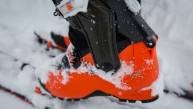
Winter is well and truly here in the Northern Hemisphere, and if you know where to look, the waves have been pumping! A little cold is no excuse to skip your dose of surf stoke, so here are 7 tips to help make cold water winter surfing more enjoyable.
Having spent several years living on the wild and windy coast of Northeast Scotland (and more recently surfing some glacial-melt river waves in the Alps), I like to think I know a little about cold water. Most of the world gets better surf in winter than summer, and Scotland is no exception.
Sure, given the choice, most of us would opt for a surf destination warm enough to surf in board shorts, but there's a actually lot to be said for the chillier oceans on this planet. When you walk down the beach at Aberdeen in a blizzard, with -13°C air temperatures and a distinctly slushy tinge to the shore break, you know you're not going to have any crowds to compete with!
Whether you're heading to Norway, Ireland, New England, surfing at home, or even going heli-surfing in New Zealand, cold water surf destinations often equal great waves with out any crowds.
Here are 7 tips to make really cold water surfing more enjoyable.
Tip #1: You're Going to Need a Proper Wetsuit
Neoprene. There's no way around it: if you want to actually enjoy those frigid waves, good rubber is absolutely essential. Buy the best 5 mm suit you can afford. Liquid-sealed seams are key, and ideally go zipperless or chest zip to minimise flushing of freezing ocean water. Likewise, repair any rips or tears; while a couple of holes aren't a big deal in summer, you'll really notice the cold water flooding in. Look for a suit with a good warm lining, and consider a quick dry lining, as nothing puts a damper on a session liking struggling into a soaking wetsuit in a windy car park in winter.
Pay attention to sizing and fit too. Though wetsuits are getting more and more flexible, if your suit is too tight, it will restrict blood flow, making you feel colder quicker. If you're surfing really cold water, maybe even consider a heated suit or vest.
Forget the macho banter and get a good pair of boots, gloves and a hood, too. You can't surf if you can't feel your feet, and stubbing clumsy toes on sharp rocks somehow hurts even more when your feet are useless lumps of frozen flesh. A good hood will help prevent both ice cream headaches on duck dives and the dreaded exostosis... No one wants a drill in the ear canal.
Tip #2: Pregame your session right with proper eats and a stretch
Don't set yourself up for failure before you've even started. Fuel yourself properly before your imminent gladiatorial contest with the ocean with a good dose of complex carbs, protein and water. Make sure you're warm before getting changed–blast the heaters in the car on the way to the beach. Layer up with a good down jacket for the pre-session surf check.
RELATED: Breaking down base layer material and technology for skiers and snowboarders
Stretch and warm up on the beach before getting in the water. When you immerse yourself in icy water, your body's natural defence mechanism is to reduce blood flow to your skin and extremities; the aim is to reduce heat loss from the skin, and keep warm blood in your core to protect vital organs. Unfortunately, this can also make your hands and feet near-unusable, which rather defeats the whole object of going surfing.
Warming up before heading into the water gets your blood pumping strongly right from the start, extending the amount of time you can feel your toes. This is also one of the benefits of heated suits: when your core is warm, your body feels less need to shut off blood flow, so your feet stay warm and functioning for longer.
Tip #3: Moisturizer and Vaseline Are Your Friends
Spending a lot of time in cold water and strong winds is pretty disastrous for your skin and lips. No one likes dry, cracked lips, so do yourself a favor and rub in a liberal amount of moisturize–the thicker and denser the better–before your session. Put a layer of Vaseline over the top to keep the moisture, and repeat after your post-surf shower. Your boy/girlfriend will be thankful.
Tip #4: Pick a Bigger, Thicker Board Than Your Summer Stick
Winter normally brings bigger and better waves–why else would you brave the hypothermia and ice cream headaches? There's also a theory that cold water is denser, heavier and more powerful than warm, which when combined with your heavier and less flexible wetsuit, means you're going to need a little extra help to get into the waves. Pick something a little bigger and with more volume than your normal summer board, and your sessions will involve more stoke and less beatdowns.
Tip #5: While You're out there, keep paddling and keep moving
Keep moving. The more you move and paddle, the warmer you'll stay, and the more warm blood your body will pump around to your hands and feet. Race to make it over the top of cleanup sets and try to avoid duck diving as much as possible.
When you're sitting on your board, try tucking your hands into your armpits to keep the warm. Alternatively, hold your arms down at your sides with your hands turned out like you're trying to emulate a penguin, and shrug your shoulders up and down: you can really feel how this forces warm blood down into your hands.
If all else fails, remember all that water you drank earlier to avoid dehydration can double up as your very own mobile heating device... Yep, there's something weirdly satisfying about peeing in a wetsuit (just don't forget to wash it after!).
Don't stay out too long! Surfing in really cold water is very tiring, as your body expends a lot of energy trying to stay warm. Head in while you still have some energy left to navigate the shore break. Always surf with a buddy, and keep an eye on each other. Watch out for signs of hypothermia.
Tip #6: Bring Boiling Water For The Post-Surf Change
 Hot water will help make the miserable post-surf changover less so.
Hot water will help make the miserable post-surf changover less so.
Getting changed after your session is probably the worst part of the whole experience, as the wind knifes into your exposed skin across some blustery car park. In a perfect world we'd all have a van to get changed in, but there are a few cheaper methods to make it less miserable.
Try filling a big water bottle with boiling water before you leave the house. By the time you've finished surfing the water will be a more manageable temperature, and you can use it rinse the sand and salt off in reasonable comfort, while warming your feet up again.
Organize your towel and clothes before getting in the water, so everything is at hand in the right order to pull on quickly. Use the hot water bottle to warm up your underwear and t-shirt so they're nice and toasty.
Tip #7: Make the most of the post-surf high
Getting warm and toasty after prolonged exposure to the cold is one of the most exquisite feelings in the world, so make the most of it! Wrap up warm in thick wool jumpers and a down jacket, build a fire on the beach, drink some whiskey, head to the pub for a pie and pint... everything feels better after a good surf, and you've earned some creature comforts!
























